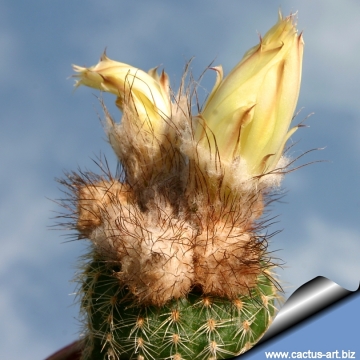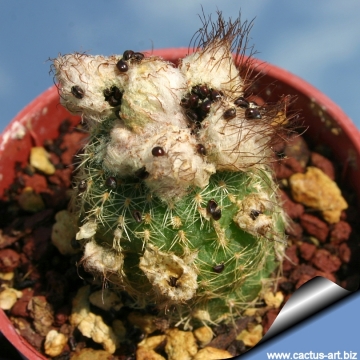




Your support is critical to our success.
Acta Mus. Richnov., Sect. Nat. 12(1): 12. 2005
Family: CACTACEAE
Accepted Scientific Name: Frailea pygmaea var. aurea (Backeb.) Backeb.
Cactaceae (Backeberg) 3: 1661. 1959 Backeb.

Origin and Habitat: Uruguay near Montevideo. (Dept. Canelones, Puenta-Ballena?)
Synonyms:
- Frailea pygmaea var. aurea (Backeb.) Backeb.
- Astrophytum aureum (Backeb.) Halda & Malina
- Frailea aurea Backeb.
- Frailea oreopygmaea var. aurea (Backeb.) Prestlé
Frailea pygmaea (Speg.) Britton & Rose
Cactaceae (Britton & Rose) 3: 210. 1922 [12 Oct 1922]
Synonymy: 59
- Frailea pygmaea (Speg.) Britton & Rose
- Astrophytum pygmaeum (Speg.) Halda & Malina
- Frailea pygmaea var. aceguaensis Prestlé
- Frailea pygmaea var. albispina
- Frailea pygmaea subs. altigibbera (F.Ritter) P.J.Braun & Esteves
- Frailea pygmaea var. altigibbera F.Ritter
- Frailea pygmaea var. applanata Prestlé
- Frailea pygmaea var. argenta Prestlé
- Frailea pygmaea subs. asperispina (F.Ritter) P.J.Braun & Esteves
- Astrophytum asperispinum (F.Ritter) Halda & Malina
- Frailea asperispina F.Ritter
- Frailea pygmaea var. atrofusca Backeb.
- Frailea pygmaea subs. aureinitens (Buining & Bredero) P.J.Braun & Esteves
- Astrophytum aureinitens (Buining & Bredero) Halda & Malina
- Frailea aureinitens Buining & Bredero
- Frailea pygmaea subs. aureispina (F.Ritter) P.J.Braun & Esteves
- Astrophytum aureispinum (F.Ritter) Halda & Malina
- Frailea aureispina F.Ritter
- Frailea pygmaea var. auricantha Prestlé
- Frailea pygmaea var. bagensis Prestlé
- Frailea pygmaea var. brunneo-mollispina hort.
- Frailea pygmaea var. cabucaensis Prestlé
- Frailea pygmaea var. carpinteria Prestlé
- Frailea pygmaea var. castaneoidea Prestlé
- Frailea pygmaea var. catiensis
- Frailea pygmaea var. corallina Prestlé
- Frailea pygmaea var. curvispina F.Ritter
- Frailea pygmaea var. dadakii (Frič ex A.Berger) Backeb.
- Astrophytum dadakii (Frič ex A.Berger) Halda & Malina
- Echinocactus dadakii Frič ex A.Berger
- Frailea dadakii Frič ex A.Berger
- Frailea oreopygmaea var. dadakii (Frič ex A.Berger) Prestlé
- Frailea pygmaea var. elegantissima
- Frailea pygmaea var. gemmrichii Prestlé
- Frailea pygmaea var. gloriosa Prestlé
- Frailea pygmaea var. grandiflora
- Frailea pygmaea subs. hyssooniana Prestlé
- Frailea pygmaea var. insignia Prestlé
- Frailea pygmaea var. krausiana Prestlé
- Frailea pygmaea var. largoensis Prestlé
- Frailea pygmaea subs. lilalunula (F.Ritter) P.J.Braun & Esteves
- Frailea pygmaea var. lilalunula F.Ritter
- Frailea pygmaea var. longispina F.Ritter
- Frailea pygmaea var. maior F.Ritter
- Frailea pygmaea var. minanensis
- Frailea pygmaea var. mollispina-brunnea Prestlé
- Frailea pygmaea var. montana Prestlé
- Frailea pygmaea var. olimarensis Prestlé
- Frailea pygmaea var. planicosta F.Ritter
- Frailea pygmaea var. pulcherrima (Arechav.) Prestlé
- Astrophytum pulcherrimum (Arechav.) Halda & Malina
- Echinocactus pulcherrimus Arechav.
- Frailea pulcherrima Speg.
- Malacocarpus pulcherrimus Britton & Rose
- Frailea pygmaea var. sakusiana
- Frailea pygmaea var. salascana
- Frailea pygmaea var. salusiana
- Frailea pygmaea var. santanaensis Prestlé
- Frailea pygmaea var. viridilunula Prestlé
Frailea pygmaea subs. albicolumnaris (F.Ritter) Hofacker
Cactaceae Consensus Init. 6: 11. 1998
Synonymy: 3
- Frailea pygmaea subs. albicolumnaris (F.Ritter) Hofacker
- Astrophytum albicolumnare (F.Ritter) Halda & Malina
- Frailea albicolumnaris F.Ritter
Frailea pygmaea var. aurea (Backeb.) Backeb.
Cactaceae (Backeberg) 3: 1661. 1959
Synonymy: 4
- Frailea pygmaea var. aurea (Backeb.) Backeb.
- Astrophytum aureum (Backeb.) Halda & Malina
- Frailea aurea Backeb.
- Frailea oreopygmaea var. aurea (Backeb.) Prestlé
Frailea pygmaea subs. fulviseta (Buining & Bredero) P.J.Braun & Esteves
Succulenta (Netherlands) 74(3): 131 (1995)
Synonymy: 3
- Frailea pygmaea subs. fulviseta (Buining & Bredero) P.J.Braun & Esteves
- Astrophytum fulvisetum (Buining & Bredero) Halda & Malina
- Frailea fulviseta Buining & Bredero
Description: Frailea pygmaea as the name implies ("pygmaeus" meaning dwarf), is a very small cactus that lives half buried in the ground. Most of the plants in habitat are single headed unless they are damaged. The "aurea" form is very nice, due to it golden-yellow spines and yellowish- or brown-tomentose areoles. The flowers are yellow and opens only during the sunniest summer days.
Root: Long tuberose, inversely conical and branched.
Stem: 2 to 2.5(-3) cm in diameter and 1.5 cm above the ground (more in cultivation) flattened, dull-green to yellowish-green, depressed at the crown, with a turbinate base. Apex partially covered with sulfur yellow spines.
Ribs: 16-18 quite flat, divided by transverse depression into very minute rounded tubercles.
Areoles: Yellowish-tomentose (brown in original description ), l.5 mm long and 1 mm wide becoming bare with time, to 5 mm apart.
Radial spines: 12-14, c. 4 mm long, golden-yellow, quite fine, partially interlocking, bristly, more or less adpressed, pointing laterally (pectinated) and downward.
Central spines: 0-1 similar to radial spines 5 mm long, more erect.
Flowers: Yellow, arising from the crown from a very woolly bud, often cleistogamous, 2 to 2.5 cm, up to 3 cm diameter, pale yellow, with dense, whitish to rose-colored pubescence outside.
Blooming season: Hottest part of summer.
Fruit: 8 mm wide and 1 cm long, round, yellowish, with bright yellowish brown wool and long dark brown bristle forming a pointed head of bristles. Bristles not pungent.The fruit wall is thick, membranous, fragile and it opens by a basal pore to release the seeds that are promptly harvested by ants.
Seeds: Helmet shaped, shining, black .
Taxonomy notes: Frailea aureaSN|3317]]SN|3529]] was briefly described by Backebg in 1935, however, from this time onward, most of the F. aurea collected over the years in habitat and currently in cultivations, are not forms of Frailea pygmaeaSN|3529]]SN|3317]], but forms of Frailea pumilaSN|2188]]SN|2188]]! Further confusion has been added by the fact that F. Ritter in his edition "Kakteen in Sudamerika", vol. 1, Pag. 209, described a Frailea aureispina (FR 1386) and A. Buining collected a Frailea HU 89 with the provisional name Frailea pumilaSN|2188]]SN|2188]] var. aurea. Especially the latter provisional name supported the generally prevailing opinion that Frailea aureaSN|3317]]SN|3529]] Backbg. (Syn. Frailea pygmaeaSN|3529]]SN|3317]] var. Aurea) is precisely this Frailea HU 89. In the original Danish description, C. Backebg indicated as place of origin of this plant the surroundings of Montevideo in South Uruguay, but more precise indication missing, so that until today the original habitat it is not clearly known. Some plants with sulfur-yellow spines and sulfur-cleistogamous fruits matching the original description where found at “Puenta Ballena” by Prestlé in 1976; could these plants correspond to the true Fraile aurea?
Subspecies, varieties, forms and cultivars of plants belonging to the Frailea pygmaea group
- Frailea pygmaea (Speg.) Britton & Rose: is a very small cactus that lives half buried in the ground. It has a wide distribution and is very variable with some forms having heads no wider than one or two cm. Distribution: Argentina, Brazil and Uruguay.
- Frailea pygmaea subs. albicolumnaris (F.Ritter) Hofacker
- Frailea pygmaea subs. asperispina (F.Ritter) P.J.Braun & Esteves: has dark felted areoles and golden-yellow spines stronger than those normally found in F. pygmaea. Distribution: North of Quarai, Rio Grade do Sul.
 Frailea pygmaea var. aurea (Backeb.) Backeb.: has golden-yellow spines, yellowish or brown areoles and sulphur-cleistogamous fruits. distribution: Uruguay near Montevideo. (Dept. Canelones, Puenta-Ballena?)
Frailea pygmaea var. aurea (Backeb.) Backeb.: has golden-yellow spines, yellowish or brown areoles and sulphur-cleistogamous fruits. distribution: Uruguay near Montevideo. (Dept. Canelones, Puenta-Ballena?)- Frailea pygmaea subs. aureinitens (Buining & Bredero) P.J.Braun & Esteves
 Frailea pygmaea subs. aureispina (F.Ritter) P.J.Braun & Esteves
Frailea pygmaea subs. aureispina (F.Ritter) P.J.Braun & Esteves Frailea pygmaea var. curvispina F.Ritter: it has recurved, creamy-brown bristles, short to long, more or less curved backwards, twisted and interlaced. Distribution: Pantano Grande Region, Rio Grande do Sul.
Frailea pygmaea var. curvispina F.Ritter: it has recurved, creamy-brown bristles, short to long, more or less curved backwards, twisted and interlaced. Distribution: Pantano Grande Region, Rio Grande do Sul. Frailea pygmaea var. dadakii (Frič ex A.Berger) Backeb.: has globular stems, depressed on top, with about 12 ribs. It branches profusely forming dense clumps. The spines are all radial, usually 8, brownish passing to white, curved backwards and twisted.
Frailea pygmaea var. dadakii (Frič ex A.Berger) Backeb.: has globular stems, depressed on top, with about 12 ribs. It branches profusely forming dense clumps. The spines are all radial, usually 8, brownish passing to white, curved backwards and twisted.- Frailea pygmaea subs. fulviseta (Buining & Bredero) P.J.Braun & Esteves
 Frailea pygmaea var. gloriosa Prestlé: has long glassy-white spines and brown areoles. It is very nice.
Frailea pygmaea var. gloriosa Prestlé: has long glassy-white spines and brown areoles. It is very nice.- Frailea pygmaea var. grandiflora: has somewhat larger flowers. Distribution: Uruguay.
- Frailea pygmaea subs. lilalunula (F.Ritter) P.J.Braun & Esteves
Notes: Frailea pygmaeaSN|3317]]SN|3317]] has a wide distribution and is very variable with some forms having heads no wider than one or two centimetres. In accordance with the variability of the species, many names have been created for different forms, some of them correctly published but the majority invalidly and nowadays considered as synonyms.
Bibliography: Major references and further lectures
1) Curt Backeberg, F. M. Knuth "Kaktus-ABC: en haandbog for fagfolk og amatører" Gyldendal, 1935
2) K.H. Prestlé “Die Gattung Frailea (Br. & R.) Prestlé” third edition - 1998
3) David R Hunt; Nigel P Taylor; Graham Charles; International Cactaceae Systematics Group. "The New Cactus Lexicon" dh books, 2006
4) Marlon C Machado. “Fascinating Frailea, Part 1: General impressions.” Cactus World (BCSS) Volume 25 No. 1 March 2007
5) Marlon C Machado.”Fascinating Frailea, Part 2: Review of the species from Rio Grande do Sul.” Cactus World (BCSS) Volume 25 No. 2 June 2007
6) Larocca, J., Machado, M. & Duarte, W. 2013. Frailea pygmaea. In: IUCN 2013. IUCN Red List of Threatened Species. Version 2013.2. <www.iucnredlist.org>. Downloaded on 15 February 2014.
7) Edward Anderson “The Cactus family” Timber Press, Incorporated, 2001
8) James Cullen, Sabina G. Knees, H. Suzanne Cubey "The European Garden Flora Flowering Plants: A Manual for the Identification of Plants Cultivated in Europe, Both Out-of-Doors and Under Glass" Cambridge University Press, 11/Aug/2011

Cleistogamus flowers and normal buds. (Frailea pygmaea var. aurea) Photo by: Cactus Art

Self pollinated fruits (Frailea pygmaea var. aurea) Photo by: Cactus Art
Cultivation and Propagation: Grow them in rich, porous soil and let them dry out between waterings. These plants need a minimum temperature of 5-10° C (but occasionally temperatures of a few degrees below 0° are not dangerous)
Sun Exposure: They enjoy full sun but in a shaded position the plants grow faster, but are not flat shaped.
Characteristically, during the dry season plants retract completely under the ground both in the wild and in cultivation too. This plant is short living (It does not live long - about 10-15 years).
Propagation: With fresh harvested seeds.
| Your Actions | |
|---|---|
| Back to Astrophytum index | |
| Back to Cactaceae index | |
 |
Back to Cacti Encyclopedia index |
Privacy stantement - Terms and conditions - How to cite - About us - Feedback - Donate



